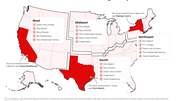Staffing
Lessons from California: 5 ways to adjust to $15 minimum wage
As national pressure grows to increase the federal minimum wage from $7.25/hour, restaurant operators must consider how to adjust their businesses to a $15 minimum wage.

June 2, 2021 by Pooja Nair
California operators have been adjusting to the $15 minimum wage increase for the past five years. In 2016, the state passed SB-3, which mandated a phased increase of the minimum wage from 2017 to 2022. Under that law, California's minimum wage will increase to $15 per hour for businesses with 26 or more employees on Jan. 1, 2022, and for all businesses on Jan. 1, 2023. Some California counties have opted to increase the minimum wage on an accelerated schedule. For example, Los Angeles County has a $15 minimum wage for employers with 26 or more employees, and on July 1, 2021, the same minimum will apply to all employers.
Here's what we've learned so far.
- Streamline processes
A higher minimum wage underscores the need for restaurant operators to understand and streamline employee processes to avoid unplanned overtime. COVID-related safety protocols, such as employee temperature checks and symptom questionnaires can add time to an employee's shift, and in California and many other states, all of this time must be accounted for and paid with no exception for de minimis time. Setting clear protocols for employees starting and ending shifts, and ensuring that employees can complete these protocols within their standard shift is key to avoiding the costs of unplanned overtime at a higher minimum wage. - Tailor your menu
With a fixed increase in labor costs due to a minimum wage increase, it is vital to carefully consider your restaurant menu. Even as the minimum wage increased, many consumers in California showed resistance to across-the-board menu price increases. Instead, more tailored menu engineering was a better solution, particularly if profitable items were featured on menus and related social media. Operators who did a comprehensive profit analysis of each menu category and tailored prices and menus accordingly were better able to adjust menu pricing to labor costs than operators adopting the same price increase for all items. Additionally, be prepared to eliminate unprofitable or labor-intensive items from the menu and focus resources on the best items. Many fast casual restaurant operators in California revamped menus as the phased minimum wage increase went forward and were able to build consumer buy-in on new menus. - Get on board with strategic scheduling
As the minimum wage increases, it is critical for operators to understand their internal data on busiest and slowest times and adapt employee schedules accordingly. More than half of California restaurants reduced employee hours in response to an increased minimum wage. However, this also has negative effects on employee retention and being able to hire new employees. Scheduling enough employees to handle consumer demand, while limiting employee shifts during non-peak times saves unnecessary labor costs. However, it is important for operators to plan and communicate schedules in advance in order to retain employees and provide visibility. Depending on the state, restaurant employees may be protected by work schedule laws, which require advance notice before adjusting shifts. - Embrace technology
Moving away from labor-intensive, manual processes and adopting technological solutions that may save time and labor costs is a key part of adapting to a higher minimum wage. This is especially true when customers have become increasingly proficient in and comfortable with mobile and online ordering. This may include self-service kiosks, point-of-sale devices, and encouraging mobile orders. - Utilize non-exempt employees
Many operators adjusting to the higher minimum wage focused on managerial non-exempt employees, and delegated more responsibilities to that category of employees. Even with a higher minimum wage, it may be difficult to retain reliable part-time employees to cover shifts for limited hours a week. If operators have a base of non-exempt employees who can be utilized to fill gaps












